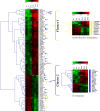Transcriptional changes in organoculture of full-thickness human skin following topical application of all-trans retinoic acid
- PMID: 24697191
- PMCID: PMC4265278
- DOI: 10.1111/ics.12121
Transcriptional changes in organoculture of full-thickness human skin following topical application of all-trans retinoic acid
Abstract
In this study, we developed an organoculture of human skin to investigate the effect of topical applied all-trans retinoic acid using a gene array approach. We could by using this approach confirm previous studies on genes activated by RA in keratinocyte monocultures and also provide new insights on genes that are relevant to RA-activation in human skin. The results in the present study show this model represent a valuable pre-clinical model for studying the effects of retinoids in skin.
Keywords: acne; cell culture; dandruff; elisa; genomics; proteomics; rosacea; skin culture; striae skin physiology; structure.
© 2014 Society of Cosmetic Scientists and the Société Française de Cosmétologie.
Figures



Similar articles
-
Comparison of gene expression profiles in human keratinocyte mono-layer cultures, reconstituted epidermis and normal human skin; transcriptional effects of retinoid treatments in reconstituted human epidermis.Exp Dermatol. 2002 Feb;11(1):59-74. doi: 10.1034/j.1600-0625.2002.110107.x. Exp Dermatol. 2002. PMID: 11952828
-
Retinoid-responsive transcriptional changes in epidermal keratinocytes.J Cell Physiol. 2009 Aug;220(2):427-439. doi: 10.1002/jcp.21784. J Cell Physiol. 2009. PMID: 19388012 Free PMC article.
-
Topical all-trans retinoic acid (RA) induces an early, coordinated increase in RA-inducible skin-specific gene/psoriasin and cellular RA-binding protein II mRNA levels which precedes skin erythema.Arch Dermatol Res. 1996 Oct;288(11):664-9. doi: 10.1007/BF02505275. Arch Dermatol Res. 1996. PMID: 8931868
-
A comparative study of the effects of retinol and retinoic acid on histological, molecular, and clinical properties of human skin.J Cosmet Dermatol. 2016 Mar;15(1):49-57. doi: 10.1111/jocd.12193. Epub 2015 Nov 18. J Cosmet Dermatol. 2016. PMID: 26578346
-
Human skin levels of retinoic acid and cytochrome P-450-derived 4-hydroxyretinoic acid after topical application of retinoic acid in vivo compared to concentrations required to stimulate retinoic acid receptor-mediated transcription in vitro.J Clin Invest. 1992 Oct;90(4):1269-74. doi: 10.1172/JCI115990. J Clin Invest. 1992. PMID: 1328295 Free PMC article.
Cited by
-
Improvement of Skin Condition Through RXR Alpha-Activating Materials.Biomolecules. 2025 Feb 17;15(2):296. doi: 10.3390/biom15020296. Biomolecules. 2025. PMID: 40001599 Free PMC article.
-
Rescue of a Vaccinia Virus Mutant Lacking IFN Resistance Genes K1L and C7L by the Parapoxvirus Orf Virus.Front Microbiol. 2020 Jul 28;11:1797. doi: 10.3389/fmicb.2020.01797. eCollection 2020. Front Microbiol. 2020. PMID: 32903701 Free PMC article.
-
Inspired by vitamin A for anti-ageing: Searching for plant-derived functional retinoid analogues.Skin Health Dis. 2021 May 27;1(3):e36. doi: 10.1002/ski2.36. eCollection 2021 Sep. Skin Health Dis. 2021. PMID: 35663133 Free PMC article. Review.
References
-
- Zouboulis CC. Retinoids–which dermatological indications will benefit in the near future? Skin Pharmacol. Appl. Skin Physiol. 2001;14:303–315. - PubMed
-
- Baldwin HE, Nighland M, Kendall C, Mays DA, Grossman R, Newburger J. 40 years of topical tretinoin use in review. J. Drugs Dermatol. 2013;12:638–642. - PubMed
-
- Griffiths CE, Finkel LJ, Ditre CM, Hamilton TA, Ellis CN, Voorhees JJ. Topical tretinoin (retinoic acid) improves melasma. A vehicle-controlled, clinical trial. Br. J. Dermatol. 1993;129:415–421. - PubMed
-
- Kligman AM, Willis I. A new formula for depigmenting human skin. Arch. Dermatol. 1975;111:40–48. - PubMed
Publication types
MeSH terms
Substances
LinkOut - more resources
Full Text Sources
Other Literature Sources

